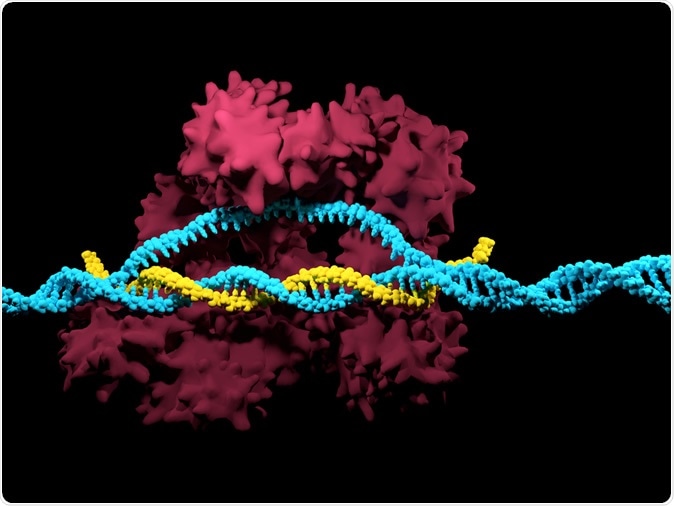HIV is a viral infection that leads to AIDS and is fatal in almost all cases. For decades now, researchers have been trying to find a complete cure for this infection that affects 37 million people across the globe. The drugs used against HIV at present are all capable of slowing the progression and multiplication of the virus within the body but do not provide complete cure or eradication of the virus.
In a new study, over 30 researchers from Temple University and the University of Nebraska Medical Center, managed to eradicate the HIV virus from lab mice DNA and this could mean development of similar cure for HIV for humans, they believe. The study titled, “Sequential LASER ART and CRISPR Treatments Eliminate HIV-1 in a Subset of Infected Humanized Mice,” was published in the latest issue of the journal Nature Communications.

CRISPR-Cas9. Image Credit: Meletios Verras
The team used a DNA editing tool called the CRISPR along with an antiviral drug. They performed their experiment in lab mice that had been modified so that their immune systems were more like humans. The therapy approach worked to eliminate the HIV in nine of 23 mice that had been “humanized”. Kamel Khalili, one of the senior authors of the study said that once the Food and Drug Administration approves, the team would start clinical trials within next year. Khalili said in a statement, “We knew what we needed to do, but the technology was unavailable.” He explained that the HIV virus has the capability to become part of the chromosomes and thus the gene editing tool like CRISPR was a boon saying that the “outcome was amazing.”
The team explained that till date the antiretroviral drugs used against HIV could keep the multiplication of the virus in the body under control. This control was seen only while the drugs were taken. Without constant medication, the virus multiplied and impairs the immunity of the patient causing the fatal AIDS. Despite the 36.7 million affected with HIV, only around 22 million actually receive antiretroviral therapy and 1 million died of the disease in 2017 says the latest report from the World Health Organization. The WHO and UNAID says that over 5,000 new cases of HIV are detected annually.
The team at Temple led by Khalili earlier has attempted to remove significant amounts of HIV DNA from rats and mice. This led to lowering of the disease burden but failed to provide a cure for the disease, said Khalili. This time the team thus collaborated with a University of Nebraska Medical Center lab team. Now the researchers attacked the virus using both an antiviral drug and the gene-editing tool.
The team used a “sequential long-acting slow-effective release antiviral therapy (LASER ART) and CRISPR-Cas9”. The mice were infected with HIV 1. The gene editing tool successfully removed the “HIV-1 subgenomic DNA fragments,” write the authors. The fragments had “long terminal repeats and the Gag gene” both of which were removed in-vivo and thus there was complete elimination of the proviral DNA from the mice. Once this was achieved, no traces of the virus could be found in the blood, lymphoid tissues, brain and bone marrow of the mice. To check for any traces of the virus, the team used “digital-droplet PCR as well as RNAscope tests.”
Howard Gendelman from UNMC in his statement said that the new drug they tried along with CRISPR had an added advantage of acting over a long time. This meant that this drug could be administered once every couple of months rather than daily as seen with commonly used antiretroviral drugs. He explained that the gene editing tool worked to eliminate the whole of the virus from the body and this new antiviral drug aided the tool to do so.
“If you can reduce the amount of virus that’s left for CRISPR, the likelihood that the CRISPR will be effective will go up enormously,” he said.
According to him, patients with HIV suffer from a stigma and a complete cure would be a boon to them. He said, “There’s a tremendous stigma. Every time you take those pills you’re reminded that you have HIV.”
According to Khalili, the new antiviral drug developed by the UNMC has not yet been approved for human use. Thus, their clinical trials may go forth with standard antiretroviral drugs against HIV and the gene editing tool. The team explains that the process of gene editing in humans would have its set of challenges. The team thus, to bridge the gap would try the gene editing on primates and apes before moving on to humans, they explain.
Journal reference:
Sequential LASER ART and CRISPR Treatments Eliminate HIV-1 in a Subset of Infected Humanized Mice, JO - Nature Communicationsvolume 10, Article number: 2753 (2019), https://doi.org/10.1038/s41467-019-10366-y